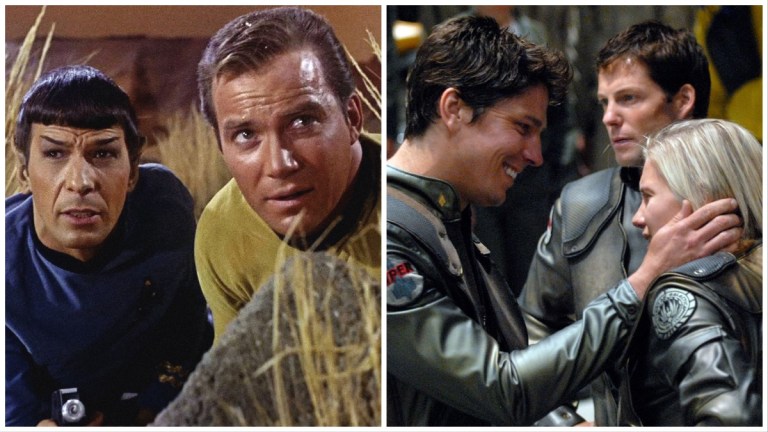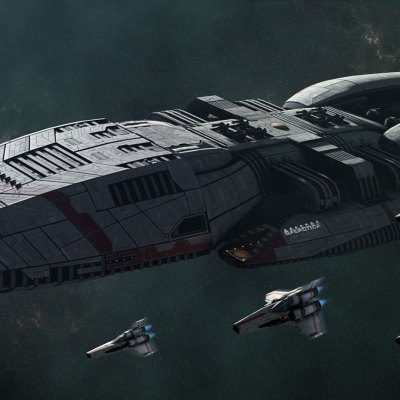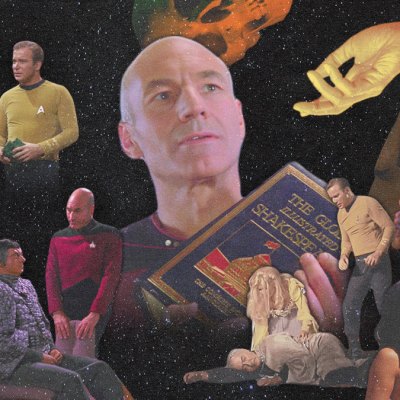How Battlestar Galactica and Star Trek Built Upon Each Other
The sci-fi universes of Battlestar Galactica and Star Trek are more inspired by each other than you might think.

This article contains spoilers for Star Trek and Battlestar Galactica.
When future television historians are asked to build the Mount Rushmore of fictional adventures through the galaxy, there is certainly room for debate. Rest assured though, there is a place for Star Trek and even a franchise many didn’t think would make it, Battlestar Galactica.
When Battlestar was released on ABC in 1978, it was almost a decade since Gene Roddenberry’s perennial trek had aired, failed, and was resurrected because of fan support. Since its inception, Star Trek was a survivor, and one of its strengths was always reinvention. This led to feature films, a renaissance of the property in the late ‘80s, and a recent reinvention and “refuel” treatment in the past few years.
Galactica, meanwhile, went from cult classic to mainstream critical success with its reboot in the early 2000s. Yet, that wasn’t the only reinvention in that franchise of note. It’s well known that Battlestar attempted to bottle the lightning in a bottle that Star Wars created and transfer that love of intergalactic battles to the small screen, but it may be Trek that forged deeper bonds with BSG more than anything else.
From the late ‘70s onwards, the two franchises shared key moments of evolution which changed the respective properties. There is a cycle of inspiration and homages where the two shows kept feeding and leading each other in new exciting directions.
Battlestar Galactica Borrowed Star Trek’s Anti-War Subtext
When Roddenberry created Star Trek, he used the science fiction backdrop to hide an overall subtext within the “final frontier.” At the time, not only was Star Trek an overall beacon for hope, it was a not-so-subtle protest of the Vietnam War. Roddenberry and his writing team constantly brought up the war within the context of 23rd century humanity and the advances we have made, and the Enterprise and crew would often visit a “savage” planet ravaged by war.
When the creative team behind the original series was asked at a 1992 convention whether the showrunners intended specific episodes to subtextually explore anti-Vietnam-war rhetoric, producer Robert Justman simply replied, “Of course we did.” The Star Trek episode “A Private Little War” had the sinister Klingon empire providing a small, savage planet with weaponry, which prompted Captain Kirk (William Shatner) and Doctor McCoy (DeForest Kelly) to debate the morality of the issue.
Kirk even asked “Bones” if he remembered the Vietnam conflict of 20th century Earth. “What would you have suggested—that one side arm its friends with an overpowering weapon?” Kirk poses. “Mankind would never have lived to travel space if they had. No. The only solution is what happened back then: balance of power.”
In fact, both Trek and BSG had specific references to limiting communism and communist countries supplying armaments to an enemy of the protagonists. A later episode in the run of BSG, episode 19 entitled “Experiment in Terra,” was about a mysterious Ship of Lights appearing, hijacking Apollo (Richard Hatch), and sending him to the planet Terra who are in the middle of wartime negotiations between the Eastern Alliance faction, and the Nationalists.
The episode is a clear allegory of the Cold War, and reintroduced a common theme within the original BSG, which is that governmental authority can be inept, a concept they often showed in the governing “Quorum of Twelve” and ever since the premiere episode, “Saga of a Star World”
Battlestar Galactica Also Borrowed Some of Star Trek’s Optimism
Gene Roddenberry, a former pilot in World War II, used the difficult lessons humanity learned during that time to create and enlighten. Having survived such hardships and seeing how dark humanity can really get, Roddenberry somehow had a powerful optimism for the future he couldn’t contain. He envisioned a future where we coexisted peacefully, reached out to new civilizations, and learned from one another.
When Battlestar Galactica first aired in 1978, it did not share the same optimism that Trek did. It was more of a Serling-esque warning, a grim look into a dark abyss that showed what would happen if war never ceased, if humanity was in its death throes after centuries of war with the unstoppable Cylons. Yes, it was an obvious nod to George Lucas’ Star Wars, and BSG certainly took the ‘Battle’ part of their title very much to heart, but there was a sudden shift that leaned a little more toward Trek than War.
No, it wasn’t merely the Mormon-subtext of Battlestar Galactica thanks to creator Glen A. Larson’s religious beliefs, but those homages certainly helped. It was in the unexpected big changes in the latter half of the show’s run where BSG had to evolve, and it seemed to look to that same optimism that Trek had that caused a rabid fanbase to write thousands of letters to Desilu studios to get the show back on the air.
The show technically ran only one season, but aired over the better part of a year. In that time, it was retooled by ABC, which gave the show a new air time, and significantly reduced its budget. Without the same level of funding, BSG’s overall arc of the first season and a battle for survival against the Cylons took a back seat to more episodic stories, not unlike Star Trek
In the later episodes, the tone became slightly more optimistic – perhaps the creators knew they had to wrap up the entire story just in case they weren’t picked up. The new episodic feel of these self-contained episodes were not only more “innocent” – having no long-standing repercussions in the BSG universe, but they even borrowed from classic Trek episodes.
Some of the adventures included “Greetings from Earth” where Apollo and Starbuck (Dirk Benedict) come across an alleged vessel from Earth. When they get inside, they discover half a dozen people in suspended animation. It was a premise used by both the original Star Trek series, and The Next Generation, where it was a chance for Roddenberry to show audiences just how “advanced” the characters in the Trek universe are and how we’ve improved as a species.
Often the Cylon take a backseat in later BSG, as well. They are no longer the unstoppable killing machines hot on the trail of the Galactica. Even when they are included in later episodes, their attack prowess is laughable, as our plucky heroes can easily defeat dozens of them. The “war” is barely mentioned anymore near the end of the show’s run, and it’s more about tiny little space adventures.
The Next Generation Borrowed from Battlestar Galactica
So with the original BSG picking up where Trek left off in terms of subtext and messages of morality, what would happen when Star Trek: The Next Generation would reboot Roddenberry’s vision of a beautiful future?
Granted, the exploits of the Enterprise D on The Next Generation very much embodied the original Roddenberry vision of a peaceful federation of planets, perhaps even more than the original, but TNG was not afraid to go in the Battlestar direction. The fact that Picard was so much more a diplomat that perhaps any character in the original series appears as if the writers of TNG embraced the great performance of Lorne Green’s Commander Adama, a man who would command respect because of his strength and his patience. Kirk is more of a man of action, with his second-in-command, Spock often taking the more reserved side of intergalactic political relations. More importantly, TNG was never afraid to delve into serious socio-political issues, and it wasn’t merely because times had changed from the’ 60s to the late ‘80s. In a sense, they weren’t afraid to go a little more into the dark parts of the universe, much like early BSG did.
Critics and connoisseurs of Trek will agree that the show truly hit its stride in season 3. There was the Q (John Delancy) episode where he discovers what it is to be mortal. There was a great Data (Brent Spiner) episode where he discovers what it is to be a father. The unforgettable “Yesterday’s Enterprise” where an old crew member is resurrected in a dark alternate timeline, and one of the greatest hours of science-fiction ever put on the small screen – “The Best of Both Worlds”.
Those last two examples embraced a truly dark tone. Something that was strangely refreshing in the Trek universe. More importantly, the latter episode, which served as the greatest cliffhanger in the show’s history featured the Federation’s greatest nemesis to date, the Borg – a cybernetic species that will not rest until all of humanity is either destroyed or serves their collective. Not a far stretch that a killer robotic force hellbent on humanity’s destruction can be seen as a connection to the original BSG.
BSG to DS9 and Back Again
While TNG was the instigator, the true renaissance of Trek can be pinpointed to the massive expansion the property had in the late 1990s and early 2000s. Yet let it not be forgotten that this was also the time the show began to become darker. The Trek franchise seemed to embrace more and more of the early BSG mentality, becoming more about survival, anti-war rhetoric, and surprisingly religious undertones.
The most obvious comparison was that of arguably the most underrated Star Trek series – Deep Space Nine. The Commander of the space station, Benjamin Sisko (Avery Brooks) in the pilot of the show was outright venomous towards the stalwart Captain Picard (Patrick Stewart). Sisko was a survivor of war, like many of the characters in the show, and when he met the man he knew to be (partially) responsible for the casualties the Federation suffered, he was not afraid to show his disdain. It was a beautiful moment where the showrunners were literally showing how different the two shows and their tones were going to be – almost akin to a literal slap in the face of TNG at the hands of the angrier, Gen X upstart, DS9. Even Voyager years later, while slightly more optimistic than the gritty DS9, used the premise of a singular vessel on a seemingly no-win voyage home. It was also more about survival than exploration, and seemed to embrace the BSG mentality as much as Jayneway embraces coffee.
DS9’s strongest seasons featured an ongoing war, much like BSG. The format of the original Battlestar run even changed the format of Trek for the first time, as it was the first time that Star Trek had adopted a more serialized structure, and had a real thread in its seasonal arc. It was tense, it was about survival, and as a result, it was really easy to become invested in the characters.
One of the threads that came out of the Dominion War storyline in DS9 was that the “Founders,” a race of Changelings that could take on the form of whatever they chose, were slowly infiltrating the ranks of Starfleet and their allies. This again, served as a great tension builder throughout the final seasons of the show, and interestingly could be seen as a throwback to the paranoia of the Cold War era and the fact that there may be “Communists among us”.
That seemed to be something the creators of the reimagined Battlestar Galactica (2004) clung to. Not an uncommon trope, but for two science-fiction shows that revolve around survivors of a devastating war, who are simply trying to rebuild, that seems more of an homage than mere coincidence. The possibility of coincidence shrinks even more if one considers that Ronald D. Moore, a writer and producer who worked on 30 episodes of Deep Space Nine then became the showrunner of the newest Battlestar Galactica in his post Trek career.
Moore as showrunner seemed to latch on to the Cold War drama of DS9, which coincidentally only existed because of influences from the original Battlestar. The new BSG for almost its entire run became about the fear that “they’re among us” as some of the key Cylons appeared human, setting up a few shocking moments within the show as the truth was ultimately revealed as to their true origins.
Battlestar Galactica and Star Trek in the Modern Era
Is there such a thing as too edgy, or too political in these shows? The 2004 BSG series contained the subtext of the 9/11 attacks, still fresh in the mind of Western culture when the show debuted, and so gave that fear of those who have survived this world changing event even more of an emotional punch.
In the last two decades, there also hasn’t been a recent iteration of BSG, and so in that time, it has been up to Trek to push the boundaries in terms of political intrigue and drama, and push they have. Part of the newest generation of Star Trek shows, including Star Trek: Discovery and Picard, have become very jaded. In fact, Picard heard public outcry from fans that the showrunners Akiva Goldsman, Michael Chabon, Kirsten Beyer, and Alex Kurtzman forgot where the beloved and stalworth captain came from. Picard himself throughout the first two seasons was pessimistic and jaded, and despite the intrigue of seeing that side of the character, it did not seem to fit with what fans had fallen in love with.
Discovery seemed to borrow heavily from the dark tone of both generations of BSG. The first season was full of several key, high-ranking characters and their sinister mirror-verse doppelgangers, so once again, the infiltration of Star Fleet at the show’s starship was a major plot device. For a long time viewers are simply not sure who they can trust. The show also turned the volume knob on the drama to 11, as there was nary an episode that went by that didn’t have a main character in tears. It’s perhaps the most realistic human experience we’ve seen on Trek, but does it push it too far?
On the flip side, this newest generation of Trek has also given audiences a satire animated show (which is still canon) in Lower Decks and the delightful Strange New Worlds which is the closest show to the original serialized and fun-loving adventure style of the original series. It was almost as if the absence of a recent iteration of BSG left Trek creators with an unsurety, should they go dark, or should they go lighthearted? Should they be optimistic, or should they embrace a gritty “realiness”?
With there being Battlestar projects in the works in the past few years, including a canceled Bryan Singer film adaptation, and more recently, Peacock wanting to continue the 2000s iteration with Mr. Robot’s Sam Esmail as showrunner, it is only a matter of time until that property is revisited, while at the same time Trek’s expansion seems to be in the middle of a second renaissance. Does this mean that a new BSG will come full circle, and once again look to the adventures of the original Enterprise?
Perhaps the cycle will break and the shows go boldly where no one has gone before. Frak. Who knows.


